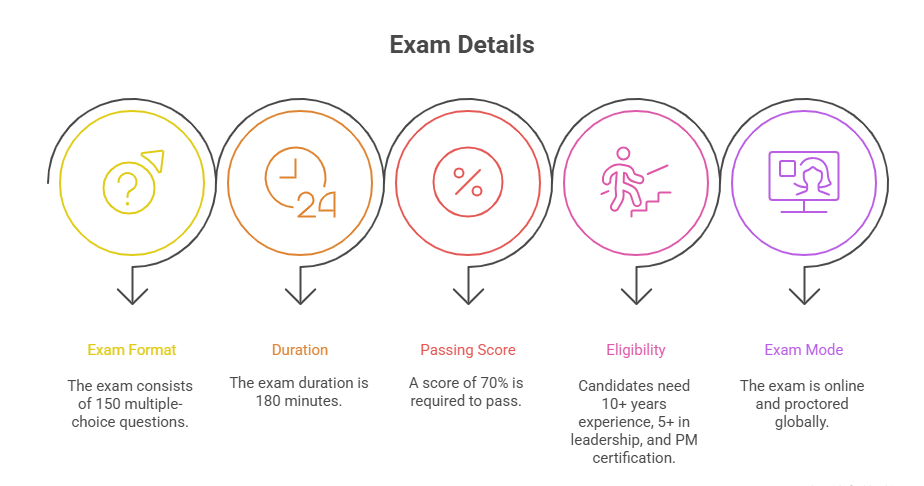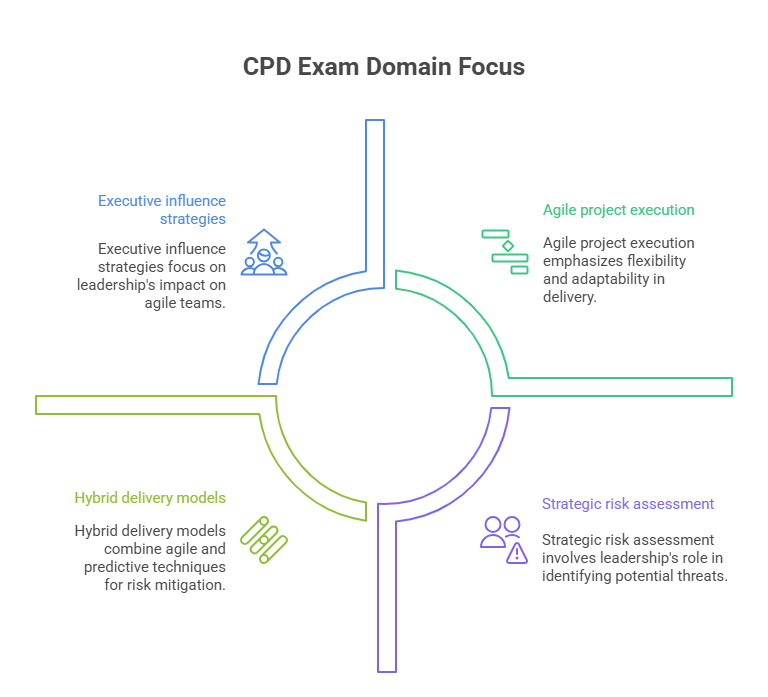Complete Guide to Certified Project Director (CPD) Certification Exam
For seasoned project managers aiming to move into executive roles, the Certified Project Director (CPD) certification represents the pinnacle of achievement. Unlike entry-level credentials, CPD validates your ability to lead enterprise-wide projects, direct cross-functional teams, and align execution with strategic business goals. It’s designed specifically for senior project professionals who want to go beyond technical management and step into high-impact leadership.
This guide dives deep into everything you need to know to pass the CPD exam and unlock advanced leadership opportunities. We’ll cover the exam format, eligibility, key topics, and insider strategies that top scorers use. If you're looking to transition from tactical execution to strategic direction, mastering this certification is your next smart move.
What is the Certified Project Director (CPD) Certification?
The Certified Project Director (CPD) certification is a globally recognized credential awarded to senior-level project professionals who demonstrate the ability to manage and direct complex, large-scale initiatives. Unlike more technical or process-driven certifications, CPD is strategically focused—it signals mastery in enterprise-wide project leadership and strategic alignment with organizational objectives.
CPD vs. Other Project Management Certifications
While certifications like PMP or PRINCE2 focus on frameworks and execution, CPD targets those responsible for leading programs with multi-million-dollar budgets and multinational teams. CPD holders are expected to operate at a governance level, making decisions that impact company-wide outcomes—not just project-level metrics.
Strategic Value of CPD
Organizations look for CPD-certified professionals to step into roles that require more than just planning and monitoring. These roles demand strategic foresight, stakeholder diplomacy, and high-level risk oversight. CPD demonstrates you have the executive-level thinking needed to lead PMOs, transform delivery models, or run parallel programs with interdependent outcomes.
Global Credibility and Advancement
CPD is issued by GAQM (Global Association for Quality Management) and is internationally respected. Earning it not only boosts your professional standing but also puts you in the running for director-level roles, program sponsor positions, or consulting assignments in high-stakes environments.
Exam Structure and Requirements
The CPD certification exam is designed to evaluate not just your project management skills but your readiness for enterprise-level leadership. It goes beyond process knowledge to assess how well you can apply strategic thinking across programs, portfolios, and organizational change initiatives.
Eligibility Requirements
To sit for the CPD exam, candidates must demonstrate extensive project experience. You’ll need:
A recognized project management certification (e.g., PMP, PRINCE2, or equivalent)
10+ years of project management experience, with at least 5 years in a leadership or program management role
Formal education is not mandatory, but a bachelor’s or master’s degree strengthens your profile
This isn't an entry-level test—it targets professionals already operating at a senior level.
Exam Components
The CPD exam consists of 150 multiple-choice questions to be completed in 180 minutes. The content is weighted toward:
Strategic alignment of project goals
Portfolio and program integration
Leadership, governance, and stakeholder management
The exam is proctored online and can be taken globally. A minimum score of 70% is required to pass. Unlike some certifications, there is no formal interview or oral defense—your performance on the written test alone determines certification eligibility.
Preparation is crucial—this isn’t a memorization test. It’s about applying experience to complex, high-stakes scenarios under pressure.
Key Topics Covered in the CPD Exam
The Certified Project Director (CPD) certification covers strategic-level knowledge areas essential for directing large-scale programs. This isn’t about task-level execution—it’s about steering the ship. The exam evaluates how you lead through ambiguity, manage risks that span continents, and make decisions that impact enterprise value.
Leadership and Management
CPD expects mastery in organizational leadership, not just team supervision. You’ll be tested on:
Building and aligning high-performing cross-functional teams
Influencing executive stakeholders without direct authority
Navigating political and cultural complexity in multinational environments
Leading change, crisis management, and strategic negotiations
Expect scenario questions where you're choosing between C-suite trade-offs rather than project schedules.
Risk Management
Risk isn’t about checklists here—it’s about business continuity and governance-level oversight. Key focus areas include:
Identifying compound and systemic risks across portfolios
Prioritizing strategic risk over tactical risk
Using quantitative models (like Monte Carlo simulations) to guide executive decisions
Communicating risk impact to boards and non-technical stakeholders
Understanding risk appetite and tolerance at the organizational level is essential.
Project Delivery Techniques
The exam requires you to adapt delivery models to the business context. This includes:
Selecting between Agile, Hybrid, and Predictive methodologies based on enterprise need
Designing governance structures for program oversight
Managing interdependencies between initiatives and balancing resources
Driving value delivery across the project lifecycle—not just meeting scope and time
You’ll face questions that ask: how do you deliver transformational outcomes, not just completed projects?
Study Tips and Resources for Success
The CPD exam is not a memory test—it’s a decision-making exam. Your success hinges on how well you align your preparation with real-world leadership scenarios. Strategic preparation will not only help you pass but also refine your executive thinking.
Recommended Books and Materials
Don’t waste time on surface-level guides. Focus on materials that sharpen strategic project leadership:
The Standard for Program Management by PMI – essential for understanding governance, benefits realization, and portfolio linkages.
Harvard Business Review’s Project Management Handbook – for executive-level leadership perspectives.
GAQM’s official CPD training manual – your core study framework.
Use these to build framework fluency, not memorize facts.
Practice Exams
Practice questions reveal how CPD tests your ability to apply judgment under pressure. Use:
GAQM’s official sample exams
Third-party platforms that simulate situational and risk-based scenarios
Aim for at least three full-length practice exams, each followed by deep review. Track your logic—why you chose the answer, and whether it reflects a director’s mindset.
Strategic Study Approach
Create a study schedule with dedicated time blocks (2 hours/day over 4 weeks works well)
Simulate exam conditions weekly to improve decision speed
Join a peer study group or LinkedIn community for exposure to real-world cases
This is a strategy test. You’re preparing not just to answer correctly—but to think like a project director.
| Preparation Area | Best Practices |
|---|---|
| Study Material | Use GAQM manual, The Standard for Program Management, and HBR Project Management Handbook |
| Practice Exams | Complete at least 3 full-length, scenario-based mock exams under timed conditions |
| Study Strategy | Study 2 hours per day, simulate exam conditions weekly, and join peer groups for discussion |
Career Opportunities Post-CPD Certification
The Certified Project Director (CPD) certification doesn’t just elevate your title—it transforms your career trajectory. It signals to employers that you’re equipped to lead enterprise-level programs, manage multi-million-dollar budgets, and influence strategic outcomes.
Roles You Can Qualify For
Post-CPD, you’re eligible for high-impact leadership positions such as:
Program Director
Head of PMO (Project Management Office)
Portfolio Manager or VP of Projects
Transformation Lead or Change Director
These roles typically come with 6-figure salaries, broader decision-making authority, and direct collaboration with executive leadership.
Industries That Value CPD
CPD is industry-agnostic. Its value is recognized in:
IT and Software Development
Construction and Engineering
Finance, Healthcare, and Government
Consulting and Global Operations
Anywhere there’s strategic change or complex delivery, CPD opens doors.
Strategic Advantages
Beyond promotions and salary bumps, CPD helps you:
Lead PMOs that define how entire organizations deliver value
Navigate boardroom-level discussions with confidence
Gain access to global consulting or contract leadership opportunities
In short, CPD turns you from a project executor into a strategic decision-maker companies trust with transformation.
| Role Title | Typical Responsibilities |
|---|---|
| Program Director | Lead enterprise-wide initiatives, manage large teams and multimillion-dollar budgets |
| Head of PMO | Oversee project governance, align portfolios with strategic goals, and define delivery frameworks |
| Portfolio Manager | Balance programs, track ROI, manage interdependencies across initiatives |
| VP of Delivery | Drive strategic transformation, report to executive leadership, and ensure outcome alignment |
How APMIC’s Project Management Certification Prepares You for the CPD Exam
If you’ve already completed the Project Management Certification by APMIC, you’re positioned to approach the CPD certification exam with a major strategic advantage. APMIC’s program focuses on practical application, cross-functional leadership, and adaptive methodology—all of which directly align with the real-world scenarios tested on the CPD exam.
While APMIC’s certification builds core strength in managing project scope, budgeting, timelines, and team dynamics, it also introduces:
Strategic project planning and alignment
Stakeholder and governance navigation
Risk mitigation in multi-phase projects
These competencies form the backbone of the CPD exam, where you’ll be asked to evaluate complex programs, make high-level tradeoffs, and lead initiatives that impact enterprise objectives.
The CPD exam assumes you're already fluent in foundational project execution. APMIC’s certification ensures you are—and more importantly, that you can think like a director, not just a manager. That shift is what sets successful CPD candidates apart.
Frequently Asked Questions
-
The Certified Project Director (CPD) certification is a high-level credential designed for senior project professionals who manage complex, cross-functional programs. Unlike entry-level certifications, CPD validates your ability to align project execution with business strategy, oversee multimillion-dollar initiatives, and lead enterprise transformations. It’s ideal for those already managing programs, portfolios, or PMOs who want to move into director or VP-level roles. Candidates typically have 10+ years of experience in project leadership. If you’re already certified in PMP or have completed the Project Management Certification by APMIC, CPD is your next strategic move to demonstrate executive-level capability and global leadership potential.
-
CPD is not a replacement for PMP or PRINCE2—it’s an advancement. While PMP focuses on tactical execution and PRINCE2 emphasizes process control, CPD evaluates how well you strategically manage portfolios, stakeholder dynamics, and risk at scale. It expects you to lead with executive oversight rather than checklists. PMP and PRINCE2 are excellent foundations, but CPD proves you're capable of handling board-level accountability, cross-border programs, and transformation leadership. If PMP teaches you how to manage a project, CPD prepares you to direct entire portfolios aligned to business objectives—that’s the critical difference.
-
To be eligible for the CPD exam, you need:
A recognized project management credential (e.g., PMP, PRINCE2, or APMIC)
A minimum of 10 years of project experience, with at least 5 years in a leadership or program management role
Experience overseeing large-scale projects, cross-functional teams, or enterprise-level delivery
While a bachelor’s or master’s degree is not mandatory, it strengthens your profile. Candidates must demonstrate strategic leadership and a strong understanding of project governance, risk oversight, and benefits realization. This is not for beginners—it’s designed for those already functioning at a senior level of project responsibility.
-
Start by mastering the CPD exam blueprint and using GAQM’s official training manual. Supplement your study with The Standard for Program Management and HBR’s Project Management Handbook. Schedule focused daily sessions (90–120 mins), and complete at least three full-length practice exams that simulate scenario-based questions. Don’t memorize—train your strategic thinking. Join LinkedIn groups or study cohorts to gain insights from CPD-certified professionals. The key to passing isn’t knowing definitions; it’s making smart decisions in complex case-based scenarios. Use your PMP or APMIC certification foundation to anticipate how a director would approach delivery, risk, and leadership under pressure.
-
The CPD exam consists of 150 multiple-choice questions to be completed in 180 minutes. The test focuses heavily on scenario-based decision-making, covering topics like strategic alignment, leadership, risk, governance, and program management. It is proctored online globally and requires a passing score of 70% or higher. Unlike other exams, there’s no interview, presentation, or oral defense—everything hinges on how well you perform in the written exam. The CPD test is challenging not because of obscure questions but because of how it tests executive-level thinking. Preparation and judgment—not memorization—are key to passing on the first try.
-
The Project Management Certification by APMIC builds exactly the kind of foundational expertise you’ll need to succeed in the CPD exam. It emphasizes practical execution, stakeholder engagement, and hybrid delivery models—all of which appear in CPD’s case-based questions. APMIC’s focus on real-world scenarios helps you build mental frameworks for strategic decision-making. Topics like change control, governance structures, and team leadership transfer directly into the more complex CPD context. Candidates who’ve completed APMIC typically find CPD preparation smoother because they already speak the language of programs and portfolios. It’s a natural—and powerful—stepping stone.
-
CPD-certified professionals are eligible for senior roles with six-figure salaries in most developed markets. Common titles include:
Program Director
Head of PMO
Portfolio Manager
Vice President of Delivery
These roles involve overseeing enterprise transformation, managing global teams, and aligning delivery with C-suite strategy. In the U.S., UK, and Middle East, CPD-certified directors often earn $130K–$180K annually, depending on industry and experience. The credential is respected globally, particularly in sectors like IT, consulting, construction, healthcare, and finance. It doesn’t just elevate your resume—it gives you direct access to leadership roles with budget authority and strategic control.
Conclusion
The Certified Project Director (CPD) certification isn’t just another line on your resume—it’s a signal to employers that you operate at a strategic level. If you’re already leading teams or managing portfolios, CPD validates your ability to scale those skills across enterprise-level programs with real business impact.
This guide has walked you through the certification’s purpose, structure, and career value—but success ultimately comes down to thinking like a director, not just a project manager. Use your APMIC Project Management Certification as a springboard, build your leadership mindset, and train for high-stakes decision-making.
Prepare deliberately, focus on frameworks that support judgment under pressure, and treat every study session as leadership training—not academic prep. CPD is for those ready to lead transformations, not just deliver timelines.
Ready to level up? Then this certification is your next strategic move.




